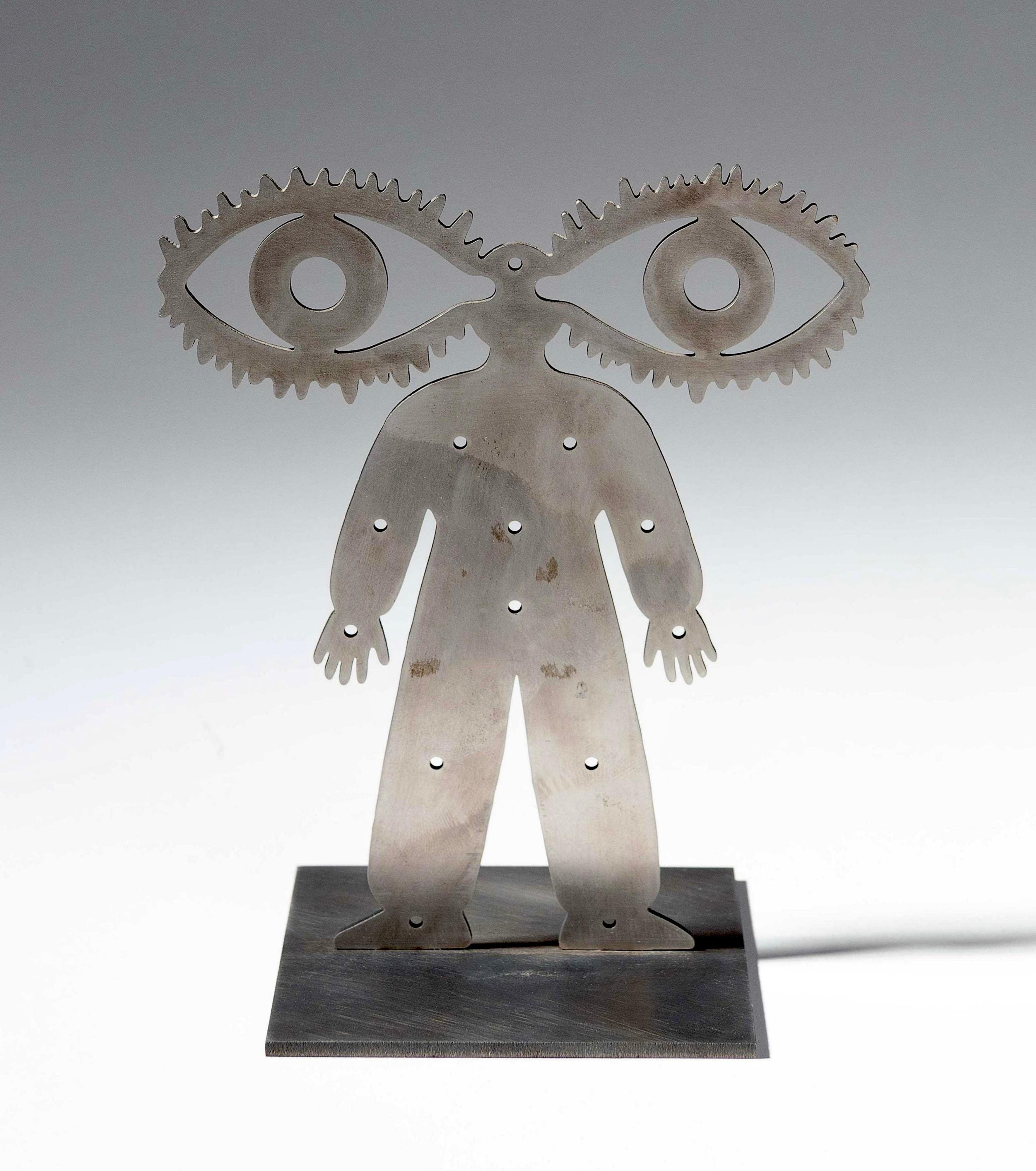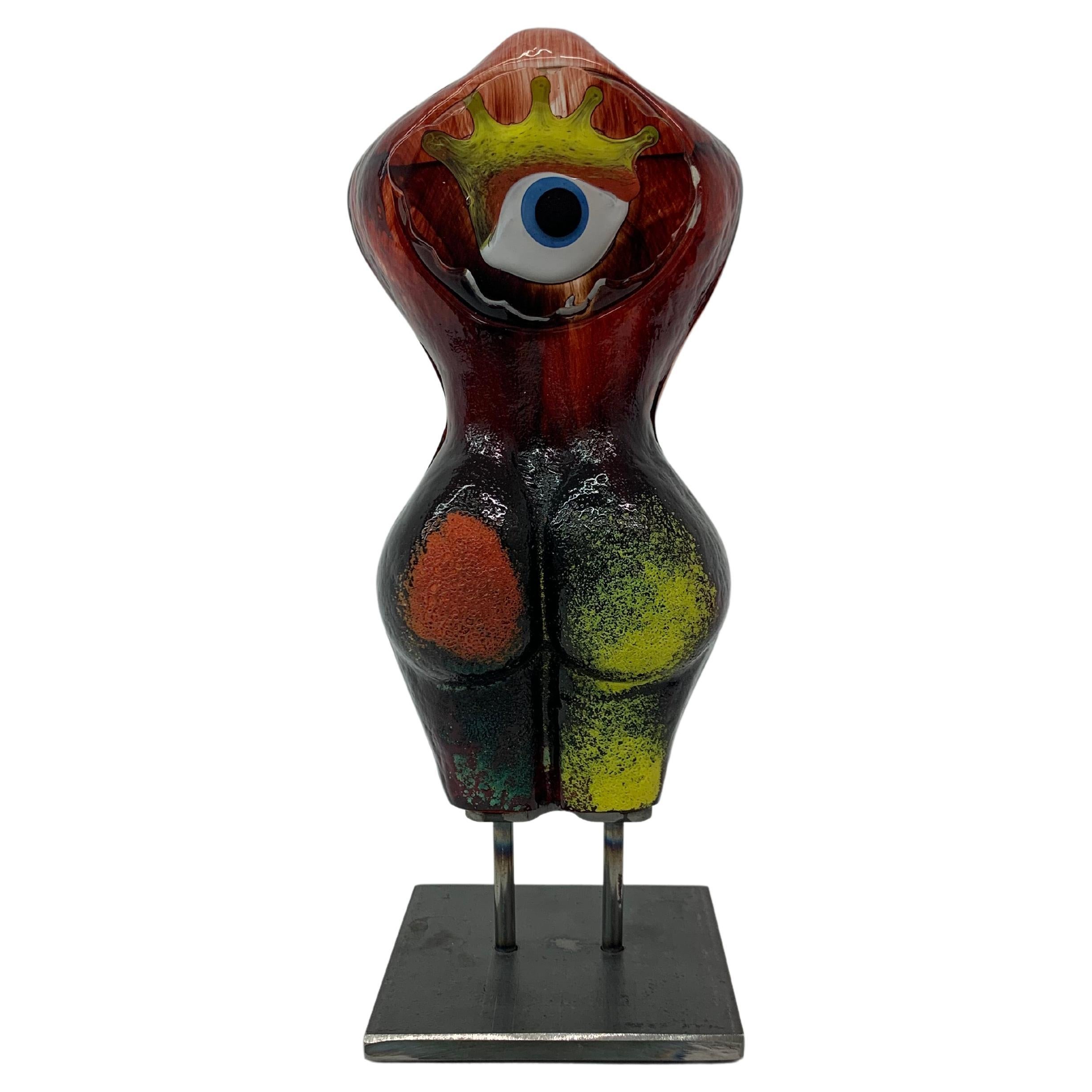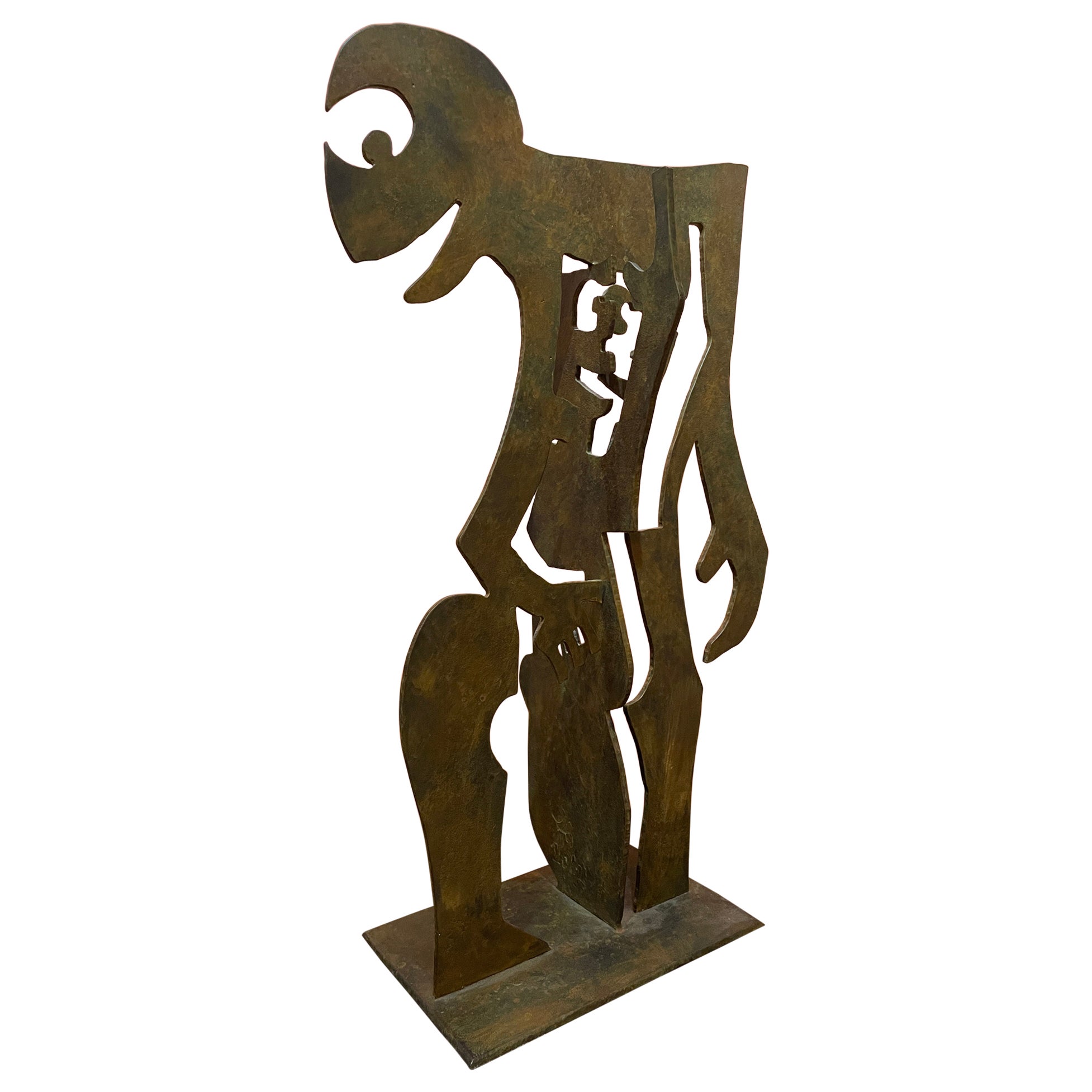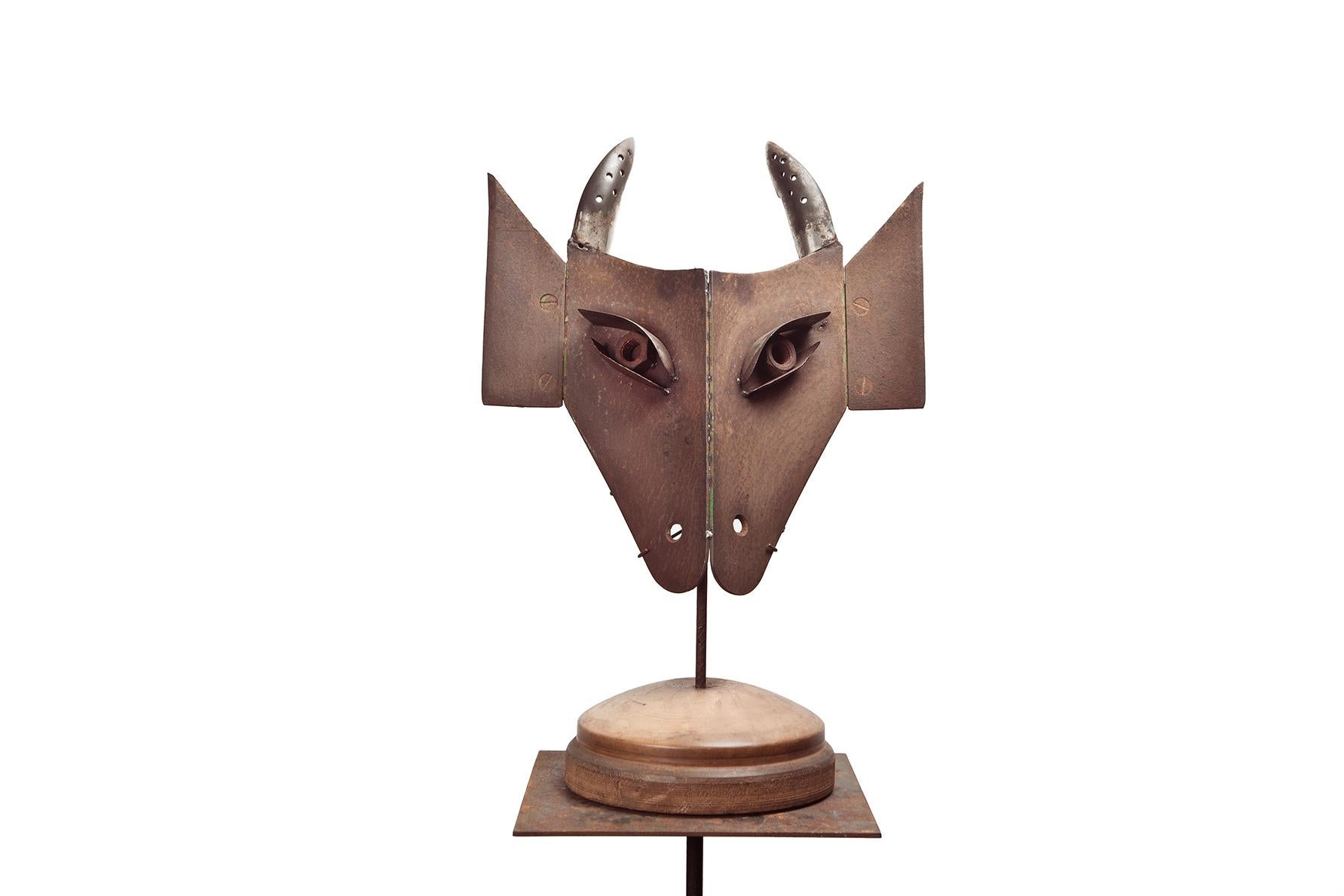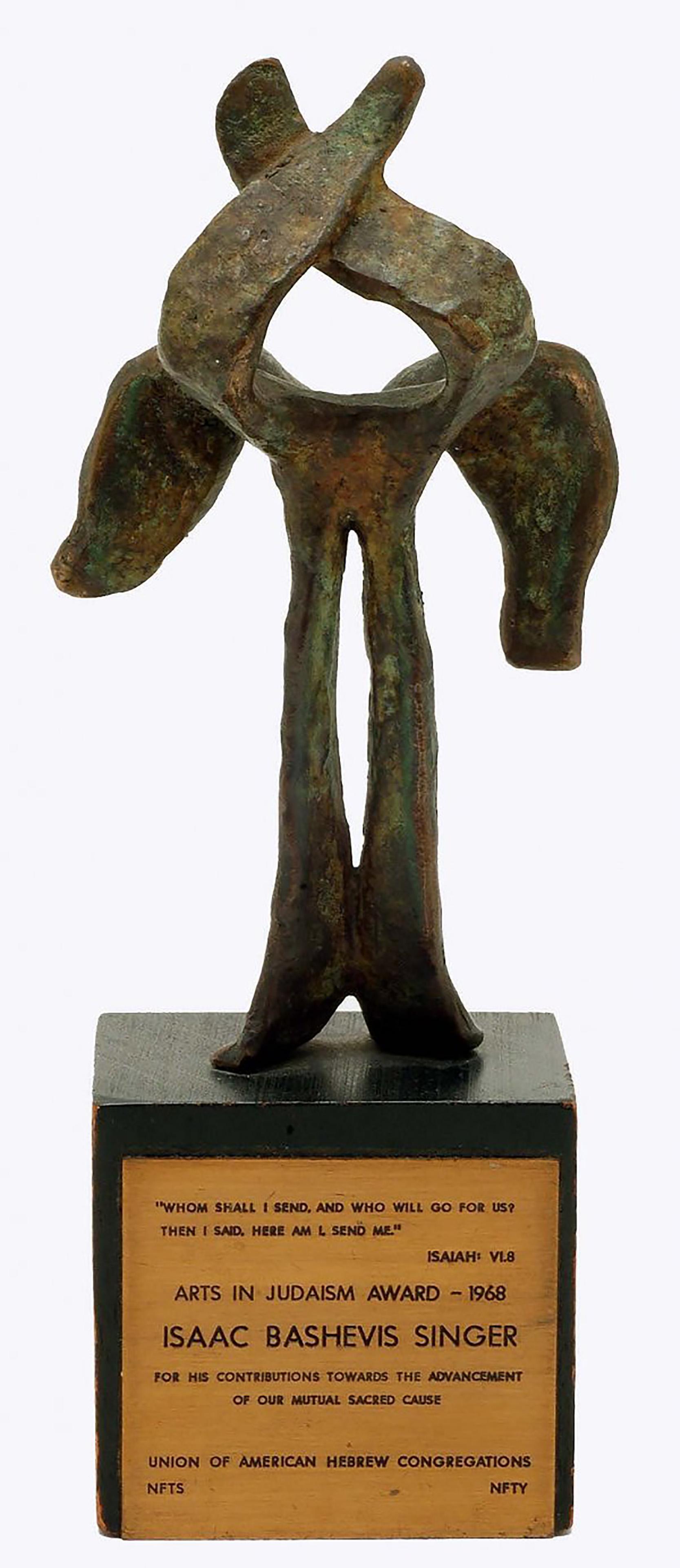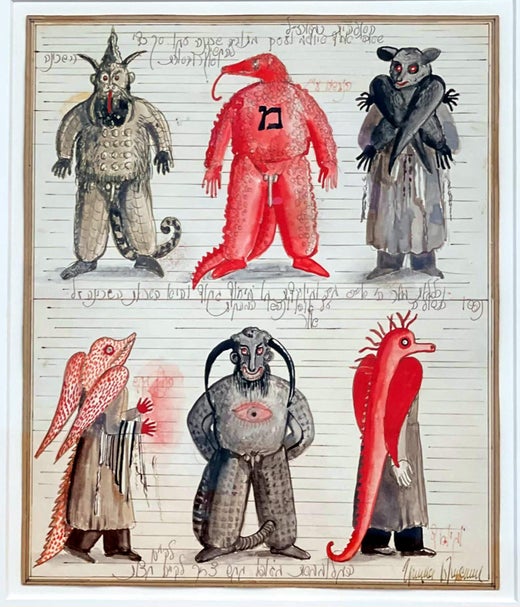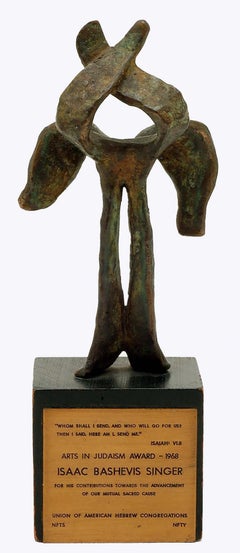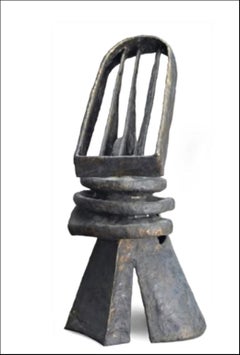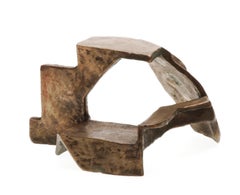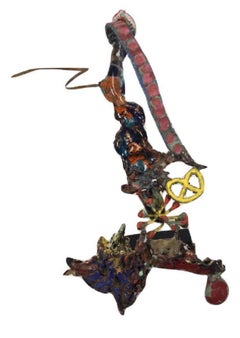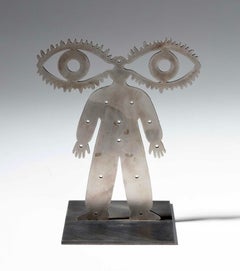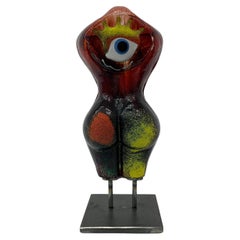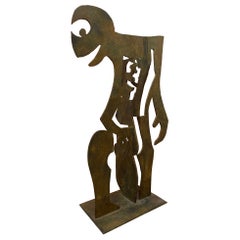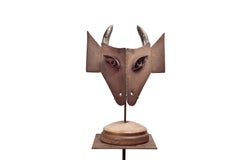Items Similar to Adam Kadmon ("Vision"), Kabbalistic Jewish Russian sculpture signed & inscribed
Want more images or videos?
Request additional images or videos from the seller
1 of 5
Grisha BruskinAdam Kadmon ("Vision"), Kabbalistic Jewish Russian sculpture signed & inscribed1992
1992
$3,500
$4,50022% Off
£2,631.08
£3,382.8122% Off
€3,050.25
€3,921.7522% Off
CA$4,886.54
CA$6,282.7022% Off
A$5,473.19
A$7,036.9622% Off
CHF 2,847.88
CHF 3,661.5622% Off
MX$66,471.49
MX$85,463.3422% Off
NOK 36,103.91
NOK 46,419.3122% Off
SEK 34,066.73
SEK 43,800.0822% Off
DKK 22,759.21
DKK 29,261.8522% Off
Shipping
Retrieving quote...The 1stDibs Promise:
Authenticity Guarantee,
Money-Back Guarantee,
24-Hour Cancellation
About the Item
Grisha Bruskin
Adam Kadmon (Vision), Signed and signed dedicated to art historian and collector Jacob Baal Teshuva), 1992
Steel Sculpture
(Signed, Dated & Dedicated)
6 × 6 × 3 inches
Edition AP (a unique inscribed proof, aside from the regular edition of 300)
Hand-signed by artist, Incised signature along with personal dedication "To Jacob/Very Friendly/Grisha Bruskin 12/5/1992".
Grisha Bruskin was chosen in 2017 to represent Russia at the Venice Biennale. This early work, "Adam Kadmon" referring to the essential soul, (also called Vision) is a theme that the artist has reprised decades later - a marvelous example of Bruskin's Kabbalistic- inspired art works. This work is especially valuable as it was acquired from the collection of renowned art historians and collectors Jacob and Aviva Baal Teshuva, bearing a personal dedication inscribed on the base of the art work. (See photographs).
In Russia, Bruskin had been accused of creating “subversive” Soviet art and “Jewish propaganda". But he's said, “We have no prejudice here. Even Russians can feel something for art. Some Russians understand the Jewish paintings and some stupid Jewish people do not. It depends upon the person.” Below is an excerpt from a 1988 New York Times profile on Bruskin:
“It is my intention to create two lines of mythology based on the mentality of socialism and Judaism,” he solemnly declares, while acknowledging the “difficulty of looking at Soviet art with Western criteria.” Bruskin’s paintings of Jewish characters are equally perplexing to some Soviets, though their meaning is not as evident because he has invented his own symbols. “In Egyptian or Assyrian art, there were symbolic equivalents of beliefs, but not in Judaism,” he says. “I was interested in creating them not at a secular level but at an artistic level.” In his Jewish-themed works, gnome-like characters may appear upside-down, carrying an angel, a menorah or a strange beast. Snippets of Hebrew text on the background call attention to the importance of the written word to Judaism. “The authority of the text is total in the Torah,” he says. “It is necessary to know how to read, but the Hebrew text in the paintings is only fragmentary. That leaves the meaning open and equivocal. “Some people have wondered if this is serious or a joke. I don’t want to dot all the I’s or cross all the T’s. Nobody will know what it means, but everybody asks.”
- Creator:Grisha Bruskin (1945, Russian)
- Creation Year:1992
- Dimensions:Height: 6 in (15.24 cm)Width: 6 in (15.24 cm)Depth: 3 in (7.62 cm)
- Medium:
- Movement & Style:
- Period:
- Condition:Very good vintage condition with natural oxidation to the metal.
- Gallery Location:New York, NY
- Reference Number:1stDibs: LU1745215075862
Grisha Bruskin
Born in 1945, the Russian artist Grisha Bruskin graduated from the Art Department at the Moscow Textile Institute in 1968. As a member of the Soviet Artists' Union, he staged a number of controversial exhibitions, most of which were closed down by the Soviet authorities. Bruskin immigrated to his current home, New York City, in 1989. Refusing to adhere to the government-sanctioned style of Socialist Realism, Bruskin became a major figure in the Soviet Non-Conformist Art movement, dedicating himself to the research and presentation of his Jewish heritage and its associated mythologies, mysticism, and sacred texts. Bruskin's work juxtaposes this powerful visual vocabulary of Judaic imagery and text with symbolic remnants of the now dissolved Soviet Union. In Alefbet (1984) and Alefbet-Lexicon (1987), his most reknown painting series, Bruskin combines Hasidic text, figures in religious uniform and a slew of Jewish mystical symbols to produce an image system. Bruskin's prints continue this exploration of the conflict between religious and political mythology, investigating the point of intersection between two prescribed notions of social identity as manifested through tradition, image and text. A prolific writer as well as visual artist, Bruskin's work is included in many permanent public collections, such as The Art Institute of Chicago, Illinois; The Museum of Modern Art, New York, NY; Jewish Museum, New York, NY; Kunsthalle Emden, Germany; State Pushkin Museum of Fine Arts, Moscow, Russia; State Russian Museum, St. Petersburg, Russia, and Museo Galeria de Arte, Caracas, Venezuela.
About the Seller
5.0
Platinum Seller
Premium sellers with a 4.7+ rating and 24-hour response times
Established in 2007
1stDibs seller since 2022
440 sales on 1stDibs
Typical response time: 2 hours
- ShippingRetrieving quote...Shipping from: New York, NY
- Return Policy
Authenticity Guarantee
In the unlikely event there’s an issue with an item’s authenticity, contact us within 1 year for a full refund. DetailsMoney-Back Guarantee
If your item is not as described, is damaged in transit, or does not arrive, contact us within 7 days for a full refund. Details24-Hour Cancellation
You have a 24-hour grace period in which to reconsider your purchase, with no questions asked.Vetted Professional Sellers
Our world-class sellers must adhere to strict standards for service and quality, maintaining the integrity of our listings.Price-Match Guarantee
If you find that a seller listed the same item for a lower price elsewhere, we’ll match it.Trusted Global Delivery
Our best-in-class carrier network provides specialized shipping options worldwide, including custom delivery.More From This Seller
View AllBronze Sculpture to Isaac Bashevis Singer, Arts in Judaism Award signed Judaica
By Nathaniel Kaz
Located in New York, NY
Nathaniel Kaz
Bronze Sculpture to Isaac Bashevis Singer for Arts in Judaism Award, 1966
Bronze, Square wooden base, Metal tag
Signed and dated "66" to back of bronze portion of the w...
Category
1960s Abstract Expressionist Abstract Sculptures
Materials
Metal, Bronze
Maquette for Laureate (unique sculpture)
By Seymour Lipton
Located in New York, NY
Seymour Lipton
Maquette for Laureate, ca. 1968-1969
Nickel silver on monel metal
Unique
18 × 8 1/2 × 7 inches
Marlborough-Gerson Gallery, New York
Acquired from the above by the previous owner, 1969
thence by descent
Christie's New York: Monday, June 30, 2008 [Lot 00199]
Acquired from the above Christie's sale This unique sculpture by important Abstract Expressionist sculptor Seymour Lipton is a maquette of the monumental sculpture "Laureate" - one of Lipton's most iconic and influential works located on the Riverwalk in downtown Milwaukee, Wisconsin. Laureate is a masterpiece that was commissioned by the Allen-Bradley Company in memory of Harry Lynde Bradley and as an enhancement for the newly constructed Performing Arts Center. It is located on the east bank of the Milwaukee River at 929 North Water Street. The Bradley family in Milwaukee were renowned patrons of modernist sculpture, known for their excellent taste who also founded an eponymous sculpture park. For reference only is an image of the monumental "Laureate" one of Milwaukee's most beloved public sculptures. According to the Smithsonian, which owns a different unique variation of this work, "The full-size sculpture Laureate was commissioned by the Marcus Center for the Performing Arts in Milwaukee. In the initial drawings, Seymour Lipton combined details from the architectural plan with a wide variety of images, ranging from musical instruments to a lighthouse on the island of Tobago. He transformed the basic shapes from these sketches into a welded sculpture, which evokes a figure composed of columns, harp strings, and coiled rope. Lipton created this piece to celebrate achievement in the arts. The dramatic silhouette commands your attention, reflecting the title Laureate, which means worthy of honor and distinction. The final version of the piece is over twelve feet high and stands out against the pale, flat buildings of the arts center.,,"
Provenance
Marlborough-Gerson Gallery, New York
Acquired from the above by the previous owner, 1969
thence by descent
Christie's New York: Monday, June 30, 2008 [Lot 00199]
Acquired from the above Christie's sale
About Seymour Lipton:
Born in New York City in 1903, Seymour Lipton (1903-1986) grew up in a Bronx tenement at a time when much of the borough was still farmland. These rural surroundings enabled Lipton to explore the botanical and animal forms that would later become sources for his work. Lipton’s interest in the dialogue between artistic creation and natural phenomena was nurtured by a supportive family and cultivated through numerous visits to New York’s Museum of Natural History as well as its many botanical gardens and its zoos. In the early 1920s, with the encouragement of his family, Lipton studied electrical engineering at Brooklyn Polytechnic Institute and pursued a liberal arts education at City College. Ultimately, like fellow sculptor Herbert Ferber, Lipton became a dentist, receiving his degree from Columbia University in 1927. In the late 1920s, he began to explore sculpture, creating clay portraits of family members and friends.
In addition to providing him with financial security, dentistry gave Lipton a foundation in working with metal, a material he would later use in his artwork. In the early 1930s, though, Lipton’s primary sculptural medium was wood. Lipton led a comfortable life, but he was also aware of the economic and psychological devastation the Depression had caused New York. In response, he generally worked using direct carving techniques—a form of sculpting where the artist “finds” the sculpture within the wood in the process of carving it and without the use of models and maquettes. The immediacy of this practice enabled Lipton to create a rich, emotional and visual language with which to articulate the desperation of the downtrodden and the unwavering strength of the disenfranchised. In 1935, he exhibited one such early sculpture at the John Reed Club Gallery in New York, and three years later, ACA Gallery mounted Lipton’s first solo show, which featured these social-realist-inspired wooden works. In 1940, this largely self-taught artist began teaching sculpture at the New School for Social Research, a position he held until 1965.
In the 1940s, Lipton began to devote an increasing amount of time to his art, deviating from wood and working with brass, lead, and bronze. Choosing these metals for their visual simplicity, which he believed exemplified the universal heroism of the “everyman,” Lipton could also now explore various forms of abstraction. Lipton’s turn towards increasing abstraction in the 1940s allowed him to fully develop his metaphorical style, which in turn gave him a stronger lexicon for representing the horrors of World War II and questioning the ambiguities of human experience. He began his metal work with cast bronze sculptures, but, in 1946, he started welding sheet metal and lead. Lipton preferred welding because, as direct carving did with wood, this approach allowed “a more direct contact with the metal.”[ii] From this, Lipton developed the technique he would use for the remainder of his career: “He cut sheet metal, manipulated it to the desired shapes, then joined, soldered, or welded the pieces together. Next, he brazed a metal coating to the outside to produce a uniform texture.”[iii]
In 1950, Lipton arrived at his mature style of brazing on Monel metal. He also began to draw extensively, exploring the automatism that abstract expressionist painters were boasting at the time. Like contemporaries such as Jackson Pollock, Lipton was strongly influenced by Carl Jung’s work on the unconscious mind and the regenerative forces of nature. He translated these two-dimensional drawings into three-dimensional maquettes that enabled him to revise his ideas before creating the final sculpture.The forms that Lipton produced during this period were often zoomorphic, exemplifying the tension between the souls of nature and the automatism of the machine.
In the years following the 1950s, Lipton’s optimism began to rise, and the size of his work grew in proportion. The oxyacetylene torch—invented during the Second World War—allowed him to rework the surfaces of metal sculptures, thus eliminating some of the risks involved with producing large-scale finished works. In 1958, Lipton was awarded a solo exhibition at the Venice Biennale and was thus internationally recognized as part of a small group of highly regarded avant-garde constructivist sculptors. In 1960, he received a prestigious Guggenheim Award, which was followed by several prominent public commissions, including his heroic Archangel, currently residing in Lincoln Center’s David Geffen Hall.
A number of important solo exhibitions of his work followed at The Phillips Collection in Washington, DC (1964); the Milwaukee Art Center and University of Wisconsin, Milwaukee (1969); the Virginia Museum of Fine Arts in Richmond (1972); the Everson Museum in Syracuse, NY (1973); the Herbert E. Johnson Museum of Art of Cornell University in Ithaca, NY (1973); the National Collection of Fine Arts, Smithsonian Institution (now the Smithsonian American Art Museum) in Washington, DC (1978); and a retrospective in 1979 at The Jewish Museum in New York. In 1982 and 1984 alone, two exhibitions of his sculpture, organized respectively by the Mint Museum (Charlotte, NC) and the Hillwood Art Gallery of Long Island University (Greenvale, NY), traveled extensively across museums and university galleries around the nation. In 2000, the traveling exhibition An American Sculptor: Seymour Lipton was first presented by the Palmer Museum of Art of Pennsylvania State University in University Park. Most recently, in 2009, the Ackland Art Museum in Chapel Hill, NC mounted The Guardian and the Avant-Garde: Seymour Lipton’s Sentinel II in Context.
Since 2004, Michael Rosenfeld Gallery has been the exclusive representative of the Estate of Seymour Lipton and has presented two solo exhibitions of his work—Seymour Lipton: Abstract Expressionist Sculptor (2005) and Seymour Lipton: Metal (2008). In 2013, Michael Rosenfeld Gallery presented Abstract Expressionism, In Context: Seymour Lipton, which included twelve major sculptures by the artist, along with works by Charles Alston, Norman Bluhm, Beauford Delaney, Willem de Kooning, Jay DeFeo, Michael Goldberg, Adolph Gottlieb, Hans Hofmann, Lee Krasner, Norman Lewis, Conrad Marca-Relli, Boris Margo, Alfonso Ossorio, Richard Pousette-Dart, Milton Resnick, Charles Seliger...
Category
1960s Abstract Expressionist Abstract Sculptures
Materials
Metal, Silver
Abstract Bronze Sculpture, Unique Signed work from the estate of Arthur Carr
By Peter Reginato
Located in New York, NY
Peter Reginato
Abstract Bronze Sculpture, ca. 1987
Bronze
Signed on the underside
4 × 6 1/2 × 5 1/2 inches
This bronze sculpture is by the American abstract sculptor Peter Reginato. ...
Category
1980s Abstract Abstract Sculptures
Materials
Bronze
Famed sculptor Nancy Graves unique signed patinated bronze sculpture NY Award
By Nancy Graves
Located in New York, NY
Nancy Graves
New York State Governor's Arts Award, 1988
Bronze, polychrome patina and baked enamel on base with Award plaque
10 1/4 × 7 × 10 1/4 inches
Hand signed and dated with inc...
Category
1980s Abstract Expressionist Abstract Sculptures
Materials
Bronze, Enamel
Untitled signed sculpture, from the collection of Dick Polich, Tallix Foundry
By Stephen Talasnik
Located in New York, NY
Stephen Talasnik
Untitled sculpture, from the collection of Dick Polich, Tallix Foundry, ca. 1997
Cast light metal
signed by the artist on the work (see close up photograph)
6 3/5 × 12 × 4 inches
Provenance
Estate of Dick Polich, founder of the legendary Tallix Foundry and Polich Art works Beacon, NY
Manufacturer
Stephen Talasnik at Tallix Foundry, Beacon, New York
This work is signed by the artist (see close up photograh)
Abstract metal sculpture
The work is lightweight so it is believed to be in aluminum or an aluminum alloy,
Provenance: acquired from the Estate of Dick Polich - founder of the legendary Tallix foundry and Polich Art Works.
Polich and Tallix fabricated significant sculptural works over many years, collaborating with such as, Willem de Kooning, Jeff Koons, Roy Lichtenstein, Frank Stella, Helen Frankenthaler, ERTE, Julian Schnabel, Richard Artschwager, Isamu Noguchi, Isaac Witkin...
Category
1990s Abstract Expressionist Abstract Sculptures
Materials
Metal
Uxmal, unique bronze sculpture by Greek-American sculptor and Harvard professor
Located in New York, NY
Dimitri Hadzi
Uxmal, 1991
Cast bronze on custom made granite base
17 × 30 1/2 × 14 inches
The title UXMAL, refers to the ancient Mayan city of Uxmal, which is known for its "Pyramid of the Magician"
Provenance:
Acquired by the original owner from the prestigious Gremillion Gallery in Houston, Texas (accompanied by a copy of the original receipt)
Measurements:
Base:
26.5 by 11 by 1.75 inches
Work longest
30.5 inches
Widest 14 inches
Highest. 17 inches
More about Dimitri Hadzi"
Derived from the figure and mythic narratives, Hadzi’s sculpture references antiquity and classical artifacts – abstracted anatomical forms, columnar and other architectural elements, helmets, weaponry and body armor function as visual metaphors for ancient cultures. “I was interested in mythology, and I was interested in movement,” Hadzi remarked on his years in Rome, “I was attempting through formal methods to exaggerate sexual tension or apprehension. Suddenly I was myself in an atmosphere of freedom.” [1] Powerfully rendered in bronze his sculptures convey raw emotion, brute strength and mass, tempered with a delicate rush of whimsy, vivacity and sensuality.
Born in New York City on March 21, 1921, Hadzi graduated from Cooper Union in 1950 and received a Fulbright Fellowship in the same year. After studying sculpture in Greece, he moved to Rome under the GI Bill where he lived for twenty-five years. Hadzi returned to the U.S. where he taught at Harvard University for fourteen years. He continued to create sculpture until his death in 2006.
Hadzi is included in the permanent collections of the Museum of Modern Art; the Whitney Museum of American Art; the Museum of Fine Arts, Boston; the Hirshhorn Museum and Sculpture Garden; The Phillips Collection and the Guggenheim Museum. Receiving over twenty sculpture commissions, Hadzi’s work appears in public squares, concert halls, federal and private plazas, and universities throughout the world.
---------------
[1] Elsen, Albert. “On Artistic Freedom: An Interview,” Dimitri Hadzi, (New York: Hudson Hills Press, 1996), 30.
Additional Biography:
Dimitri Hadzi (1921 – 2006) is among the most distinguished modernist sculptors, creator of works in bronze and stone that are powerfully abstract and expressionist in character. His contribution to the international language of sculpture continues to influence and inspire through permanent installations and collections, and exhibitions worldwide.
Born to Greek-American immigrant parents in New York City, he had a talent for drawing at an early age and won a prize for his young ability. But, it wasn't until after serving in the Air-force in the South Pacific during WWII that he turned his sights fully to painting and sculpture, going on to study both at Cooper Union. Eventually, he would become a mainstay of the Cambridge, MA art community. He was a Guggenheim Fellow (1957), the winner of the Venice Biennale Award (1962), and the Rome Prize (1974).
His most notable sculptures are: Copley Place Waterfall (Boston, MA), Owen Glass Co. (Toledo, OH), as well as Thermopolis, adjacent to Boston’s City Hall Plaza, and the former Omphalos in Harvard Square (Cambridge, MA).
Hadzi is included in the permanent collections of the Museum of Modern Art; National Gallery of Art; Whitney Museum of American Art; Museum of Fine Art, Boston; Hirshhorn Museum and Sculpture Garden; The Phillips Collection and the Guggenheim Museum.
Additionally, Hadzi was also a prolific painter, and printmaker. He also taught at Harvard University for over a decade. Famously, David Hockney attended one of Hadzi’s classes at the Carpenter Center at Harvard, where Hadzi served as director. The two of them spent time together painting and discussing techniques. Hockney gifted Hadzi one of his paintings.
He worked alongside his good friend, Nobel Prize winning Irish poet...
Category
1990s Abstract Abstract Sculptures
Materials
Granite, Bronze
You May Also Like
Russian Judaica "Vision" Abstract Kabbalah Figure Steel Sculpture Grisha Bruskin
By Grisha Bruskin
Located in Surfside, FL
Grisha Bruskin
(Russian, b. 1945)
Vision, 1992
steel
Hand signed and inscribed Grisha Bruskin in Cyrillic
numbered 117/300
Genre: Contemporary
Subject: Religious
Medium: Steel
Gri...
Category
1990s Contemporary Figurative Sculptures
Materials
Steel
Rare Kjell Engman for Kosta Boda Sculpture, 1980’s
By Kjell Engman
Located in Delft, NL
Unique piece by Kjell Engman for Kosta Boda. In mint condition. Abstract glass art.
Category
Vintage 1980s Swedish Scandinavian Modern Abstract Sculptures
Materials
Art Glass
Guido Hafner, Mensch Mit Mensch
Located in Saint-Ouen, FR
Guido HAFNER
Born in 1968
Title : Mensch mit Mensch
Technique : Bronze sculpture
Biography :
Guido Häfner is a sculptor and graphic artist who completed his studies i...
Category
20th Century Abstract Sculptures
Materials
Bronze
Máscara Vaca - 21st Century, Contemporary Figurative Sculpture, Recycled Objects
Located in Barcelona, Catalonia
Miquel Aparici's sculptures are surprising assemblages made from old objects that had other uses in the past, and which the artist recovers and uses in a creative and ingenious way. ...
Category
21st Century and Contemporary Contemporary Figurative Sculptures
Materials
Found Objects, Mixed Media
Younger brother
By Volodymyr Tsisaryk
Located in Palm Beach, FL
Bronze
Category
2010s Modern Abstract Sculptures
Materials
Bronze
"The Seer" Limited Edition Bronze Brutalist Figural Sculpture
Located in Queens, NY
Contemporary hand-forged bronze Brutalist-inspired figural sculpture depicting a wise person gazing into the future finished in an ebonized patina (PRICED EACH). ("THE SEER" - Limite...
Category
21st Century and Contemporary Asian Mid-Century Modern Sculptures and Ca...
Materials
Metal, Bronze
